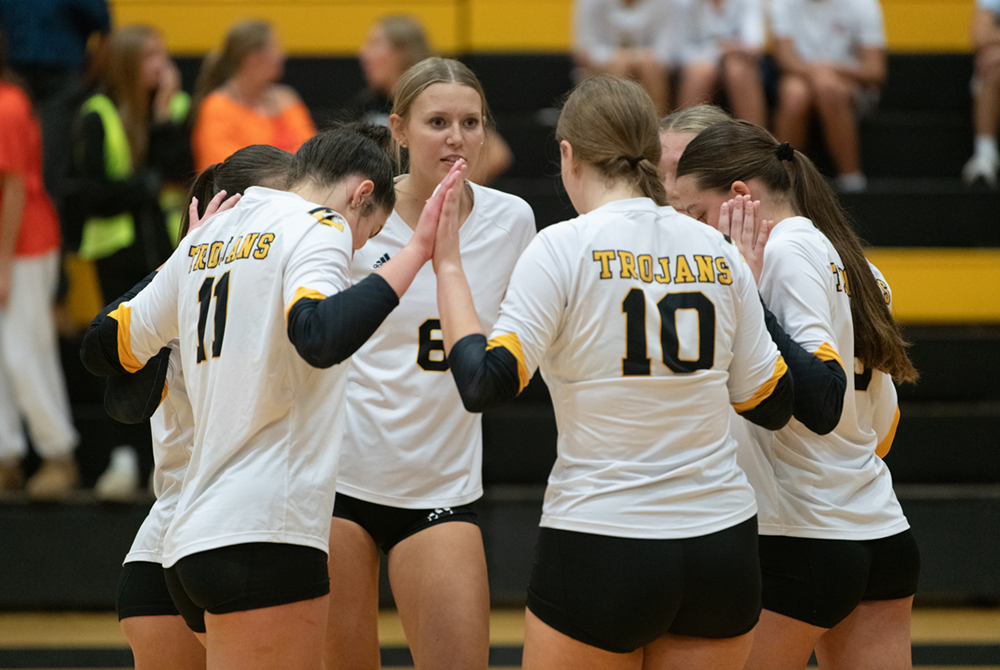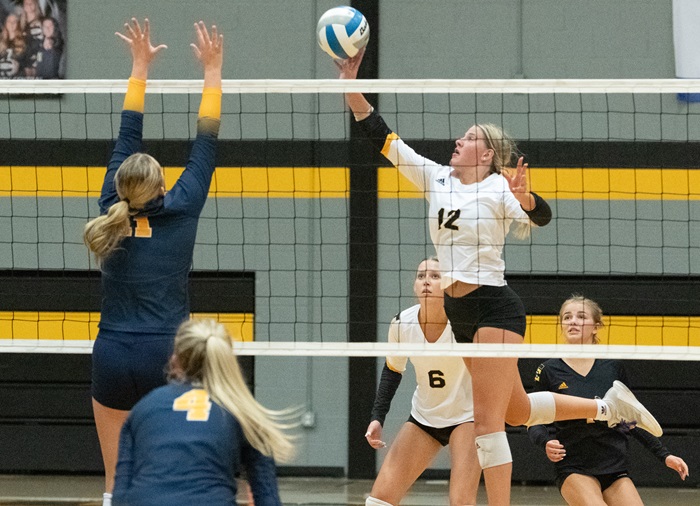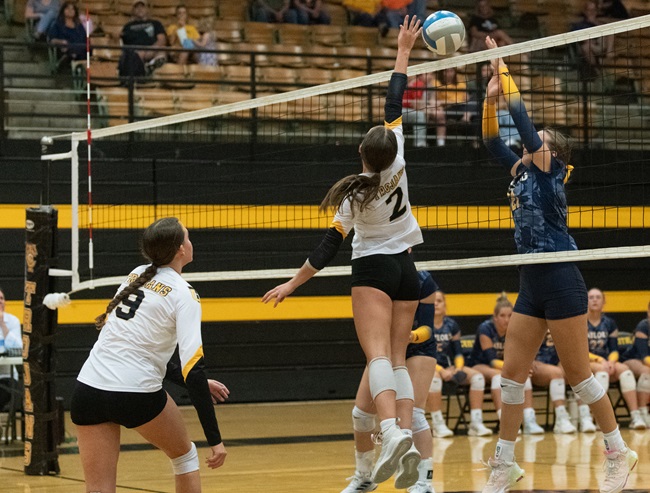
Casting Lines for Future Tournaments
August 12, 2016
By Jack Roberts
MHSAA Executive Director
The MHSAA is best known to the public for the tournaments it conducts to conclude the fall, winter and spring seasons each school year.
These tournaments, the first and largest program of the MHSAA, have survived the Vietnam War, the Korean conflict and two World Wars. They have survived the technology bubble, the housing collapse, the energy crisis and the Great Depression.
MHSAA tournaments existed at the dawn of aviation and at the time of our nation’s lunar landing. Popes, presidents and governors have changed and changed again and again, and MHSAA tournaments roll on year after year.
But the sense of tradition and permanence and inevitability of MHSAA tournaments doesn’t dissuade us from asking questions about our tournaments, even some of the most basic questions. Here are two.
Question #1
I have long been and will always be an advocate for a Ryder Cup format for the MHSAA Golf Finals, and a team tennis approach to the MHSAA Tennis Finals; but 90 years of tradition is hard to overcome. Might this be a more exciting format? Could it be co-ed? Could it reverse the decline in boys tennis participation, and increase girls golf participation? Wouldn’t it be fun to try?
Periodically, the International Olympic Committee requires each of the designated Olympic sports to defend its status, to state its case why the sport should remain a part of the Olympic program. Then, after a series or votes that retain one sport at a time, the IOC drops the sport that makes the weakest case. It does so to make room for one of the previously unlisted sports that makes the best case for inclusion.
This would appear to keep the existing Olympic sports on their toes, and to keep the Olympic movement fresh and reflective of modern trends in sports.
While I would not enjoy the controversy, I can see the potential for some positive results if the MHSAA were to invoke the same policy for determining the 14 tournaments it will provide for girls and the 14 for boys.
This might cause us to consider more deeply what a high school sport should look like, or at least what an MHSAA tournament sport should stand for.
On the one hand, we might be inclined to drop tournaments for those sports that involve mostly non-faculty coaches and non-school venues, or require cooperative programs to generate enough participants to support a team, or resort almost entirely to non-school funding, or cater to individuals more than teams.
Or perhaps this process would cause policymakers to forget traditional thinking and ask: “In this day and age, should we shake off traditional notions of sport and consider more where modern kids are coming from?” That might mean fewer team sports and more individual sports, more “extreme” sports like snowboarding and skateboarding, and more lifetime sports, meaning not just golf and tennis and running sports, but also fishing and even shooting sports.
Currently, MHSAA policy states that the MHSAA will consider sponsorship of a tournament series for any sport which 64 member schools conduct on an interscholastic basis as a result of action by the governing boards of those schools.
Should the only question be how many schools sponsor a sport, or must an activity also have certain qualities and/or avoid certain “defects?” What should an MHSAA tournament sport look like and stand for?
Question #2
Bristling from criticism that his association is a money-grabbing exploiter of children, my counterpart in another state said, “If we were running our programs just to make money, we would do very many things very differently.” I knew exactly what he meant.
Because we care about the health and welfare of students, because we mean what we say that the athletic program needs to maximize the ways it enhances the school experience while minimizing academic conflicts, and because we try to model our claim that no sport is a minor sport when it comes to its potential to teach young people life lessons, we operate our programs in ways that make promoters, marketers and business entrepreneurs laugh, cry or cringe.
If money were the only object, we would seed and select sites to assure the teams that attracted the most spectators had the best chance to advance in our tournaments, regardless of the travel for any team or its fan base. If money were the only object, we would never schedule two tournaments to overlap and compete for public attention, much less tolerate three or four overlapping events. If money were the only object, we would allow signage like NASCAR events and promotions like minor league baseball games.
Those approaches to event sponsorship may not be all wrong; they’re just not all right for us. And we will live with the consequences of our belief system.
During a typical school year, more than 20 percent of the MHSAA’s 2,097 District, Regional and Final tournaments lose money. Not a single site in golf, skiing or tennis makes a single penny. In no sport did every District, Regional and Final site have revenue in excess of direct expenses.
In fact, in only three sports – boys and girls basketball and football – is revenue so much greater than direct expenses overall that it helps to pay for all the other tournaments in which the MHSAA invests.
That’s right: invests. When we present our budget to our board, we talk about the MHSAA’s investment in providing tournament opportunities in all those sports and all those places that cannot sustain the cost of those events on their own. How much is this investment worth to students, schools and society?
These two are core questions that require our focus far in advance of talk about scheduling, site selection, seeding and the myriad matters that too often hijack our time and attention.

TC Central Upholding Program Standards with Eye on MHSAA Tournament Goal
By
Tom Spencer
Special for MHSAA.com
November 8, 2024
Traverse City Central’s volleyball team is living the dream.
 More aptly put, the Trojans are living the vision — that of third-year coach Emily Wilbert.
More aptly put, the Trojans are living the vision — that of third-year coach Emily Wilbert.
Central is 36-1-1 entering Saturday’s Division 1 District Final against Mount Pleasant and coming off a 25-22, 25-15, 25-13 win over crosstown rival Traverse City West. That was the Trojans’ fourth win over West this season and kept them on track to achieve perhaps their biggest goal – to advance in the playoffs farther than any volleyball team in the school’s history.
They are moving along living their vision clearly spelled out by Wilbert in a preseason letter to her team.
“I wrote a letter and read it to the 12 varsity players that made the 2024 varsity team the night we finished cuts,” Wilbert recalled. “In my letter I talked about standards. I talked to them about three things that were non-negotiable and that are all within their control – working hard, having a good attitude and supporting your teammates.”
Central wears a warm-up T-shirt every game with the words “WORK, ATTITUDE, SUPPORT.” The shirt was designed by captains Elyse Heffner and Marley Richmond, the only seniors on the squad, which is also coming off a third-straight Big North Conference championship. A third-straight District title is now in immediate site.
“We are starting to reap the benefits of our culture and our process,” Wilbert said this week as the Trojans entered postseason play. “We are committed to excellence in all we do. We are disciplined to the process and committed to the team – if we do these things, the results we want will follow.”
 The Trojans will play one game at a time, but the result they really want is to win a Regional title for the first time. If they do that, they could get a chance to meet one of the teams that knocked them out of the playoffs the last two years – Rockford, which won its District again this year. Grand Haven, which knocked the Trojans out last year, already has been eliminated this week.
The Trojans will play one game at a time, but the result they really want is to win a Regional title for the first time. If they do that, they could get a chance to meet one of the teams that knocked them out of the playoffs the last two years – Rockford, which won its District again this year. Grand Haven, which knocked the Trojans out last year, already has been eliminated this week.
“We’ve made it to the Regional Final once before and our coach has told us our school, our volleyball team, has never won a Regional Final,” said Heffner, a dominating outside hitter for the Trojans. “We can’t look ahead. We have to focus on the games in front of us. We still have Districts.”
Heffner led the Trojans over West with 15 kills, 11 digs, one ace and one block. Richmond, the team’s setter, had 31 assists, 10 digs and two kills.
Central’s lone loss this year was to Rockford in an early-season tournament. While trying not to look ahead, a postseason win over the Rams would be special.
“I think it would be cool to get a chance to play Rockford again,” admitted Richmond. “Our previous times playing them, we haven’t been fully ourselves.”
The only other time Central was not victorious this year was in pool play of a tournament against Grand Rapids Catholic Central. Both teams took a game for a two-set draw, but Central advanced out of the pool play. The two teams met again later this season in another tournament pool play match, and the Trojans won both games.
Coming off an undefeated conference season, the Trojans are concentrating again on Mount Pleasant. They defeated Mount Pleasant 25-17, 25-20, at their home quad late last month. The District Final will be played back at Central. The Oilers defeated Cadillac in their semifinal at Cadillac. Central’s semifinal was at West.
The Trojans have won all of their matches at home this year. They’re excited to get back on the home court, where their coach also played for the Trojans. Wilbert enjoys coaching in the Trojans’ gym as much as she enjoyed playing there; it’s her favorite place to play.
 “I love being a TCC Trojan alumni,” Wilbert proclaimed. “It feels special to have been part of this program, played four years on varsity and now to be coaching the varsity team.”
“I love being a TCC Trojan alumni,” Wilbert proclaimed. “It feels special to have been part of this program, played four years on varsity and now to be coaching the varsity team.”
Wilbert started coaching JV volleyball at Central in 2010. When you add in the time watching her sister also play for Central, she’s been “connected to the program for over 25 years.”
During those 25 she also coached some JV at West and took a break to have twins, daughter Avery and son Grady, now age 6. She has hopes Avery will someday play volleyball for the Trojans.
Wilbert measures Central’s success by more than victories, although she’s quick to point out she’s a competitive person who likes to win.
“Coaching gives me the chance to unlock a young person’s potential to maximize their growth, teach them the skills and give them the tools to be successful as a student-athlete and beyond,” Wilbert said. “I encourage them and believe in them so they can believe in themselves and create memorable moments and memories they will cherish for a lifetime.”
Heffner and Richmond have provided strong leadership for the Trojans both on and off the court. Coming into District play, Heffner led the team in serving aces (70) and kills (456). She was also second in digs with 253. Richmond was tops during the regular season in assists with 889 and second in aces at 50.
Erica Heffner, a sophomore, came into the postseason with 252 kills and 230 digs. Junior Sydney Richmond was leading the teams in digs at 265. The Trojans were also getting strong serving from freshman Macaire Kudary.
Win or lose in the days ahead, the Trojans will hold their heads high and recall a fun season.
“We’ve had an incredible season,” Wilbert said. “It’s got to be fun. When your work hard and put in the time, the results sort of come.”
 Tom Spencer is a longtime MHSAA-registered basketball and soccer official, and former softball and baseball official, and he also has coached in the northern Lower Peninsula area. He previously has written for the Saginaw News, Bay County Sports Page and Midland Daily News. He can be reached at [email protected] with story ideas for Manistee, Wexford, Missaukee, Roscommon, Ogemaw, Iosco, Alcona, Oscoda, Crawford, Kalkaska, Grand Traverse, Benzie, Leelanau, Antrim, Otsego, Montmorency, Alpena, Presque Isle, Cheboygan, Charlevoix and Emmet counties.
Tom Spencer is a longtime MHSAA-registered basketball and soccer official, and former softball and baseball official, and he also has coached in the northern Lower Peninsula area. He previously has written for the Saginaw News, Bay County Sports Page and Midland Daily News. He can be reached at [email protected] with story ideas for Manistee, Wexford, Missaukee, Roscommon, Ogemaw, Iosco, Alcona, Oscoda, Crawford, Kalkaska, Grand Traverse, Benzie, Leelanau, Antrim, Otsego, Montmorency, Alpena, Presque Isle, Cheboygan, Charlevoix and Emmet counties.
PHOTOS (Top) Traverse City Central players, including Elyse Heffner (6), Adelae Nelesen (10) and Bella Hernalsteen (11) huddle before the start of a match this season. (Middle) Central’s Macaire Kudary (12) attempts to put a ball over a Cadillac block. (Below) The Trojans’ Marley Richmond (2) attempts a one-handed block against Gaylord. (Photos by Ryan Hernalsteen Photography.)

